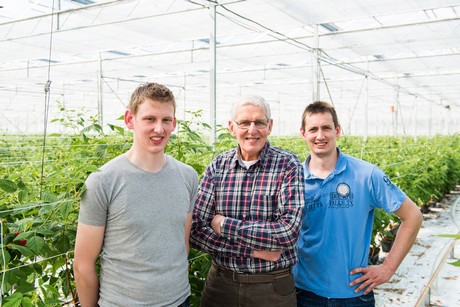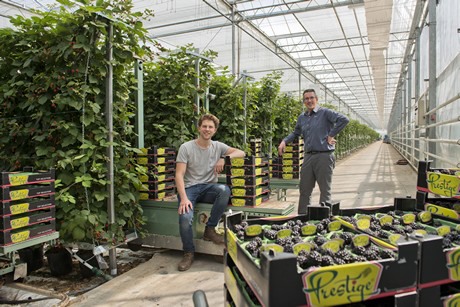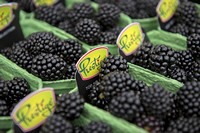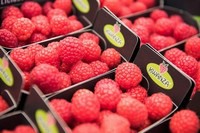Can the blueberry, blackberry or raspberry follow the strawberry from under glass? Who knows. There certainly is potential. In the shadow of the growth of strawberry cultivation under glass, the cultivation of other soft fruit under glass is steadily increasing. More and more growers are looking for opportunities to advance their harvest in this way with the ultimate goal of year-round, profitable cultivation in the greenhouse. But before the time comes, certain conditions must still be met.
Geert-Jan and his brother Kees with their father in the raspberry greenhouse
"Every year one week earlier, that is how we will get there", raspberry grower Geert-Jan van Tuijl jokes when he is asked about whether it is feasible to grow raspberries in the greenhouse year round. “Of course it's not that easy, but you try to be earlier every year and to be one of the first on the market. We can harvest from around the end of March to the end of June. With that you present yourself nicely and it is important to hold on to the customers you then have. Then we harvest again from the beginning of September till the middle of November."
With 3.5 hectares of raspberries in a Zaltbommel greenhouse, raspberry nursery Van Tuyl accounts for more than a tenth of the total Dutch acreage of 26 hectares. That means that, aside from the strawberry, it is the second largest soft fruit growing under glass. After the blackberry, which is good for 31 hectares in 2018.
In total, 123 hectares of fruit were grown under glass in the Netherlands in 2018, almost double of the number in 2015 at 64 hectares. Detailed figures from the previous years are lacking just to indicate that cultivation is still in its infancy. Just like in Belgium, where indeed cultivation did not double, but with more than 67 hectares in 2018 it grew considerably compared to the just over 49 hectares in 2015.
In particular, in recent years, many growers have joined in, stimulated by a strongly growing consumption. In the Netherlands, GroentenFruitHuis saw its volume increase by 30 percent in five years and the consumer spending even by 77 percent, of course also partly attributed to spending on open field cultivation and imported produce. Geert-Jan and his brother Kees started in 2015. In their own words, to be able to distinguish themselves, something that they could hardly do with growing bell peppers in moreover, a somewhat older greenhouse. “But it's not a step you just take. Especially the huge spikes in labor must suit you.”
Lighting tests show potential
The same labor peaks are also recognized by grower Wouter van den Bosch from Bosch Fruit in Berkel en Rodenrijs. Since 2017, he has on 1.3 hectares been growing blackberries in combination with the cultivation of peppers at a different location. According to him, much has still to be learned about the cultivation of which much is still unknown. “For example, how does the crop deal with the lighting? That is something about which there is little knowledge yet, so we participate in tests, together with crop researchers.”

Wouter with compacy director Jaco in the greenhouse
Just like in raspberries, where such tests also take place. It spells out that growers and researchers see potential in growing all year round. A group of blackberry and raspberry growers have been meeting regularly, among other things, to discuss bottlenecks in cultivation. This is an initiative from branch organization Glastuinbouw Nederland (Greenhouse Horticulture Netherlands) and the Nederlandse Fruittelers Organisatie (Dutch Fruit Growers Organization) to properly represent the interests of the growers.
Is the market situation also already a topic in this? "No, not yet", Wouter remarks. “In my opinion, little is discussed on this topic. First there are other challenges, but I would certainly be open to discuss to put the blackberry on the market together. That is a major challenge for a relatively small product such as the blackberry. "
The strawberry from Dutch and Belgian soil is by now firmly established. That is more difficult for other soft fruit. Geert-Jan: “Finding customers who want to pay a constant price, especially if you want to sell your product in the winter, is difficult. This is mainly because it is still difficult for growers to guarantee supply, a condition for getting a foothold all year round. Supermarkets want certainty about their supply and the quality thereof and that we cannot offer them year-round. You can compare it with the rise of lighted tomatoes. That was also difficult for a number of years. Only once there was constant enough supply and supermarkets could rely on it and did not have to switch, did the lighted tomato end up on the shelf. ”
Shelf life blueberry as a disadvantage
In the winter, supermarkets now still look to more southern destinations to get a lot of their soft fruit. Because of the low transport costs, importing products in the winter from Spain and Mexico is quite viable. A formidable competitor with which blackberry and raspberry growers can compete if they have continuously product available.
That is more difficult for blueberry growers. The cultivation of the blueberry under glass is completely a niche compared to the blackberry and raspberry. The vast majority of production takes place outside, whether or not covered. In the greenhouse it really is about a few "corners". Here too, it is the challenge for growers to be the first on the market, but if the weather is favorable in the spring, the lead of greenhouse cultivation on the outside growers is very limited.
Growers cannot base their entire business model on that sometimes just over a week head start. The cost price of the covered cultivation, even if it concerns nets or plastic over outdoor cultivation, is simply too high. Moreover, unlike blackberry and raspberry that have a shorter shelf life, the blueberry can easily be brought from far because it can be stored well for a month or even longer. This means that the market is more leveled out and that greenhouse growers cannot benefit from peaks in the market.
Everyone’s friend Wouter and Geert-Jan do notice such peaks in the market for blackberries and raspberries. Wouter: “Pricing in the blackberry market is difficult. There is still a lot of fluctuation at the moment. Sometimes the product is so cheap that not even labor is paid, while not much later the product can suddenly become so expensive that no customer is able to sell it. That, of course, is not a workable situation, for nobody. Now we still sell a lot based on daily prices. It would be better if an average could be established from this. We are looking hard for contracts, but they are still hard to find. Presently not many parties seem to be interested in this. A good, long term shortage on the market might change that."
Wouter and Geert-Jan do notice such peaks in the market for blackberries and raspberries. Wouter: “Pricing in the blackberry market is difficult. There is still a lot of fluctuation at the moment. Sometimes the product is so cheap that not even labor is paid, while not much later the product can suddenly become so expensive that no customer is able to sell it. That, of course, is not a workable situation, for nobody. Now we still sell a lot based on daily prices. It would be better if an average could be established from this. We are looking hard for contracts, but they are still hard to find. Presently not many parties seem to be interested in this. A good, long term shortage on the market might change that."
 Also a bit of marketing could help growers to market their product even better. Slightly easier for raspberries than for the blackberry. According to Wouter, the latter is less the "everyone's friend" that the strawberry and to a lesser extent also the raspberry is. Geert-Jan likes to point out the strength of the strawberry, which, in addition to the taste loved by consumers, also comes from the large numbers that are available and the good, stable quality. This combination means that the consumers, and therefore the supermarket, increasingly prefer homegrown products to products from the south.
Also a bit of marketing could help growers to market their product even better. Slightly easier for raspberries than for the blackberry. According to Wouter, the latter is less the "everyone's friend" that the strawberry and to a lesser extent also the raspberry is. Geert-Jan likes to point out the strength of the strawberry, which, in addition to the taste loved by consumers, also comes from the large numbers that are available and the good, stable quality. This combination means that the consumers, and therefore the supermarket, increasingly prefer homegrown products to products from the south.
The soft fruit growers are convinced of the taste of their own product, but in order to give the consumer an extra push, Geert-Jan also hopes for another possible incentive. “In marketing, in our first year we have strived for continuity and quality and we want to expand that in the coming years. The goal is to make the supermarket think of us when they think of raspberries.
Now, in the absence of sufficient supply in the winter, in the spring and in the fall, the supermarket is still too often opting for imported products, because the price is lower. Labor costs are lower over there and transport is cheaper. That is why I hope that the CO2 footprint will one day appear on the packaging. That can help just that little bit to let the consumer choose us.
Dutch and Belgian growers can win on sustainability. Just as in the field of reliability and honoring existing commitments. We are already good at that, but to be able to follow the strawberry, we still do need to increase the production considerably. ”
This article was previously published in edition 7/8, 33rd volume of trade journal AGF Primeur. See www.agfprimeur.nl for this.
For more information:
Bosch Fruit
Facebook
Wouter van den Bosch
wouter@kwekerijvandenbosch.nl
Frambozenkwekerij van Tuyl
Geert-Jan van Tuijl
info@kwekerijvantuyl.nl
